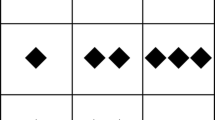Abstract
Connectionism provides hope for unifying work in neuroscience, computer science, and cognitive psychology. This promise has met with some resistance from Classical Computionalists, which may have inspired Connectionists to retaliate with bold, inflationary claims on behalf of Connectionist models. This paper demonstrates, by examining three intimately connected issues, that these inflationary claims made on behalf of Connectionism are wrong. This should not be construed as an attack on Connectionism, however, since the inflated claims made on its behalf have the look of cures for which there are no ailments. There is nothing wrong with Connectionism for its failure to solve illusory problems.
Similar content being viewed by others
References
Adams, F., Aizawa, K. and Fuller. G.: 1992, ‘Rules in Programming Languages and Networks’, in Dinsmore (ed.), (1992).
Bogdan, R.: 1986,Belief, Oxford University Press, Oxford.
Bradshaw, D.: 1991, ‘Connectionism and the Specke of Representationalism’, in Horgan and Tienson (eds.), pp. 417–416.
Brunswick, E.: 1956,Perception and the Representative Design of Psychological Experiments, University of California Press, Berkeley California.
Butler, K.: 1991, ‘Towards a Connectionist Cognitive Architecture’,Mind and Language 6, 252–272.
Butler, K.: 1993a, ‘Connectionism, Classical Cognitivism, and the Relation Between Cognitive and Implementational Levels of Analysis’,Philosophical Psychology 6, 321–333.
Butler, K.: 1993b, ‘Neural Constraints in Cognitive Science’,Minds and Machines 4, 129–162.
Butler, K.: 1995, ‘Compositionality in Cognitive Models: The Real Issue’,Philosophical Studies.
Churchland, P. M. and Churchland, P. S.: 1990, ‘Could a Machine Think?’,Scientific America 262, 32–37.
Clark, A.: 1989,Microcognition, MIT, Cambridge, Massachusetts.
Clark, A.: 1990, ‘Connectionism, Competence, and Explanation’,British Journal for the Philosophy of Science 41, 195–222.
Cummins, R. and Schwarz, G.: 1991, ‘Connectionism. Computation, and Cognition’, in Horgan and Tienson (eds.), pp. 60–73.
Dinsmore, J.: 1992,Closing the Gap: The Symbolic and Connectionist Paradigms in Cognitive Science, Lawrence Erlaum, Hillsdale, New Jersey.
Dretske, F.: 1981,Knowledge and the Flow of Information, MIT Press, Cambridge, Massachusetts.
Dretske, F.: 1986, ‘Misrepresentation’, in Bogdan (ed.).
Dretske, F.: 1988,Explaining Behavior, MIT Press, Cambridge, Massachusetts.
Enç, B.: 1981, ‘Intentional States of Mechanical Devices’,Mind 91, 161–182.
Feldman, J. and Ballard, D.: 1982, ‘Connectionist Models and Their Properties’,Cognitive Science 6, 205–254.
Fodor, J.: 1975,The Language of Thought, Crowell, New York.
Fodor, J.: 1980, ‘Searle On What Only Brains Can Do’,Behavior and Brain Sciences 3, 431.
Fodor, J.: 1987,Psychosemantics, Blackwell, Cambridge, Massachusetts.
Fodor, J.: 1991,A Theory of Content and Other Essays, MIT Press, Cambridge, Massachusetts.
Fodor, J. and Lepore, E.: 1992,Holism, a Shopper's Guide, Blackwell, Cambridge, Massachusetts.
Fodor, J. and Pylyshyn, Z.: 1981, ‘How Direct is Visual Perception? Some Reflections on Gibson's ‘Ecological Approach’’,Cognition 9, 139–196.
Fodor, J. and Pylyshyn, Z.: 1988, ‘Connectionism and Cognitive Architecture: A Critical Analysis’,Cognition 28, 3–71.
French, P, Uehling, T. and Wettstein, H.: 1977,Midwest Studies in Philosophy, University of Minnesota Press, Minneapolis.
French, P., Uehling, T. and Wettstein, H.: 1986,Midwest Studies in Philosophy 10, University of Minnesota Press, Minneapolis.
Gibson. J.: 1966,The Senses Considered as Perceptual Systems, Houghton-Mifflin, Boston, Massachusetts.
Gibson, J.: 1979,The Ecological Approach to Visual Perception, Houghton-Mifflin, Boston, Massachusetts.
Glaser, G.: 1991, ‘Is Perception Cognitively Mediated?’, in Horgan and Tienson (eds.), pp. 437–443.
Hatfield, G.: 1988, ‘Representation and Content in Some (Actual) Theories of Perception’,Studies in the History and Philosophy of Science 19, 175–214.
Hatfield, G.: 1991, ‘Representation in Perception and Cognition Connectionist Affordances’, in Ramsey, Stich and Rumelhart (eds.).
Helmholz, H. von: 1963,Treatise on Physiological Optics, in J.P.C. Southall (ed.), Dover, New York.
Horgan, T. and Tienson, J.: 1991,Connectionism and the Philosophy of Mind, Kluwer Academic Publishers, Boston.
Jacqueue, D.: 1989, ‘Adventures in the Chinese Room’,Philosophy and Phenomenological Research XLIX, 605–624.
Lehky, S. and Sejnowski, T.: 1988, ‘Network Model of Shape From Shading: Neural Function Arises From Both Receptive and Projective Fields’,Nature 333, 432.
Lloyd, D.: 1989,Simple Minds, MIT Press, Cambridge, Massachusetts.
Marr, D.: 1982,Vision, MIT Press, Cambridge, Massachusetts.
Moody, T.: 1993,Philosophy and Artificial Intelligence, Prentice Hall, Englewood Cliffs, New Jersey.
Poggio, T. and Edelman, S.: 1990, ‘A Network That Learns to Recognize Three-Dimensional Objects’,Nature 343, 263–266.
Pylyshyn, Z.: 1980, ‘The ‘Causal Power’ of Machines'’,Behavioral and Brain Science 3, 442–444.
Pylyshyn, Z.: 1984,Computation and Cognition, MIT Press, Cambridge, Massachusetts.
Ramsey, W., Stich, S. and Rumelhart, D.: 1991,Philosophy and Connectionist Theory, Lawrence Erlbaum, Hillsdale, New Jersey.
Rock, I.: 1983,The Logic of Perception. MIT Press Cambridge, Massachusetts.
Rumelhart, D. and McClelland, J.: 1986,Parallel Distributed Processing: Explorations in the Microstructure of Cognition, MIT Press Cambridge, Massachusetts.
Rumelhart, D. and Zisper, D.: 1985, ‘Feature Discovery by Competitive Learning’,Cognitive Sciences 9, 75–112.
Searle, J.: 1980, ‘Minds, Brains, and Programs’,Behavioral and Brain Sciences 3, 417–458.
Searle, J.: 1990, Is the Brain's Mind a Computer Program?’,Scientific American 262, 26–31.
Sejnowski, T. and Rosenberg, C.: 1987, ‘Parallel Networks that Learn to Pronounce English Text’,Complex Systems 1, 145–168.
Stampe, D.: 1977, ‘Toward a Causal Theory of Linguistic Representation’, in French et al. (eds.), pp. 81–102.
Treisman, A. and Gelade, G.: 1982, ‘A Feature-Integration Theory of Attention,Cognitive Psychology 14, 107–141.
Turvey, M.: 1977, ‘Contrasting Orientations to the Theory of Visual Information Processing’,Psychological Review 84, 67–88.
Turvey, M., Shaw, R., Reed, E. and Mace, W.: 1981, ‘Ecological Laws of Perceiving and Acting: In Reply to Fodor and Pylyshyn: 1981,Cognition 9, 237–304.
Ullman, S.: 1980, ‘Against Direct Perception’,Behavioral and Brain Sciences 3, 373–381.
Author information
Authors and Affiliations
Rights and permissions
About this article
Cite this article
Butler, K. Representation and computation in a deflationary assessment of Connectionist cognitive science. Synthese 104, 71–97 (1995). https://doi.org/10.1007/BF01063676
Issue Date:
DOI: https://doi.org/10.1007/BF01063676




